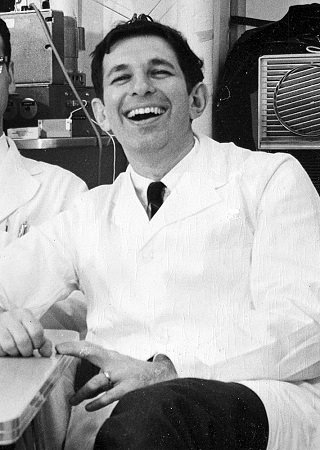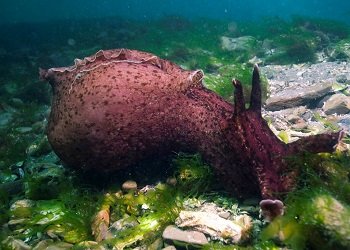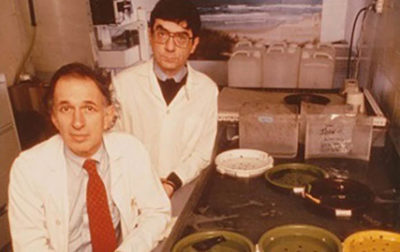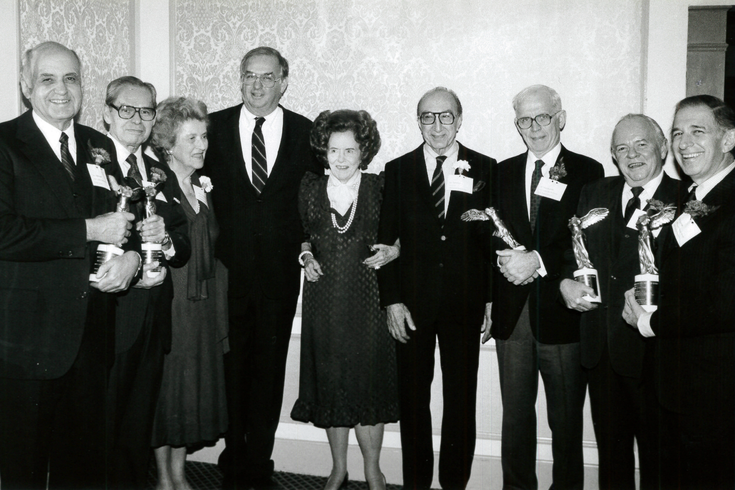As a young neuroscientist studying learning and memory, Eric Kandel made a move that his colleagues considered career suicide: he switched his model organism from cats to Mediterranean sea slugs. This fateful decision led to a fundamental understanding of learning and memory, the creation of a simpler approach to answering research questions, and the fusion of two fields of study.
 Kandel was no stranger to big changes. When he was only nine years old in 1939, he and his brother fled from Austria to America to escape World War II. The memory of that traumatic time left a profound impact, and Kandel dedicated himself to understanding the human mind. He later attended Harvard College, majored in history and literature, and in an attempt to understand how intellectuals could have supported Hitler, wrote his thesis on the response of three German writers to national socialism.
Kandel was no stranger to big changes. When he was only nine years old in 1939, he and his brother fled from Austria to America to escape World War II. The memory of that traumatic time left a profound impact, and Kandel dedicated himself to understanding the human mind. He later attended Harvard College, majored in history and literature, and in an attempt to understand how intellectuals could have supported Hitler, wrote his thesis on the response of three German writers to national socialism.
Science wasn't even on his radar. "It's a switch. I fell in love with a woman," reflects Kandel, referring to the woman he was dating at the end of college, the daughter of two prominent psychoanalysts. "They showed me how fascinating psychoanalysis is."
Kandel started medical school with the goal of becoming a psychoanalyst and then accepted a job at the National Institutes of Health (NIH), where he learned to do scientific experiments. "I was ready to become an analyst, but I fell in love with doing brain science and savored that," says Kandel.
During that time, Kandel set out to discover how memories are stored in the brain, focusing on a region called the hippocampus. "And I, being rather dumb, thought that if I just recorded from single cells in the hippocampus, I would understand how memory is stored," recalls Kandel. He became the first person to record electrical signals from single cells in the hippocampus but still had no idea how memory was stored.
"I realized that by just recording from the hippocampus, I couldn't really see how the incoming information is modified and how the output is modified," says Kandel. "I was fortunate to realize early on that even though the hippocampus is marvelous, it's too complex a problem to begin with. You need something that is much simpler."
The Power of a Slug
In contrast to the human brain, which houses over a million neurons, the brain of the giant Mediterranean sea slug has only 20,000. These cells are organized into discrete collections that govern particular behaviors. Kandel reasoned that he could study memory by observing what happened to the neural circuitry during learning. But could he teach a slug?

An image of the giant sea slug, Aplysia californica, in its natural habitat [Courtesy of Wikimedia Commons]
The team next set out to identify the cellular mechanisms and neural circuity governing this learning process. Kandel and his team placed electrodes into a single sensory neuron, which detects the external stimulus, and a single motor neuron, which translates that stimulus into a physical response.
"I could map the connection between them. I could stimulate a single sensory neuron and record [the incoming signal] in the motor neuron. One sensory neuron, one motor neuron, one modulatory neuron, and you could reconstruct the whole [neural circuit]," says Kandel.
With the map of the slug nervous system, Kandel and his colleagues went on to discover that learning modified the strength of the connections between nerve cells.

Eric Kandel, with colleague James Schwartz, observing trays containing Aplysia sea slugs
The Impact of Simplicity
"Looking back on it, the whole field seemed a little naïve, not just us," recalls Robert Hawkins, a neuroscientist at Columbia University Medical Center who worked in Kandel's lab in the late 1970s and early 1980s. "This was somewhat seriously considered the holy grail of neuroscience – to find the molecular mechanism of learning. With the wisdom of many more years since then, it's become clear that there is not a single mechanism of learning."
Even so, elucidating the neural circuitry behind simple forms of learning laid the foundation for understanding more complex forms. Kandel's reductionist approach in the slug also showed others how to study cellular mechanisms in relation to behavioral learning. "I think that made it easier for people, including myself, to try similar experiments in the hippocampus," says Hawkins. Kandel eventually uncovered the difference between short-term and long-term memory, earning him the Lasker Basic Medical Research Award in 1983 and the Nobel Prize for Physiology or Medicine in 2000.
Kandel's discoveries showed that a simple animal model could provide unparalleled insight into the mysteries of the human condition. Researchers later applied the fundamental principles learned in the slug to explore neurological and psychiatric diseases. Indeed, the slug continues to reveal fundamental mysteries relevant to all animals, which can then be explored in more complex contexts involving the hippocampus.

Eric Kandel (far right) at the 1983 Lasker Award Ceremony
Left to right: Maurice Hilleman, Saul Krugman, Alice Fordyce, Lowell Weicker, Jr., Mary Lasker, Michael DeBakey, Vernon Mountcastle, F. Mason Sones, and Eric Kandel
Kandel's work makes another lasting contribution that is often overlooked: he fused physiology and behavior. "People who were doing electrophysiology were scared as hell of behavior, and the behaviorists didn't know a damn thing about cellular neurophysiology. They were two different worlds," recalls Kandel. "I was one of the early people that brought them together. I wasn't scared of behavior like most neurophysiologists were because I was a psychiatrist. After you work with schizophrenic patients, you're not going to be scared of looking at a behavior in a mouse or a fish."
Today, Kandel is a professor at Columbia University and the director of their Kavli Institute for Brain Science. He is still fascinated by memory storage and is currently investigating what happens to memory during aging and what behaviors might aid in overcoming memory weakening. "Even after working for years with [memory], I haven't figured it out," says Kandel. "We've looked at very simple cases of learning and memory, but there are much more complicated cases…untouched areas," just waiting to be explored.
By Tiffany Garbutt
